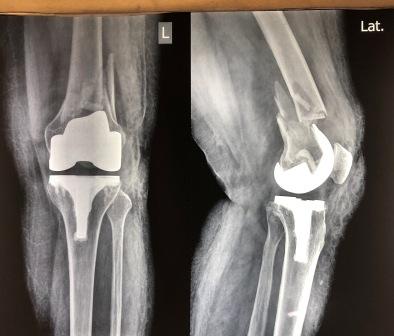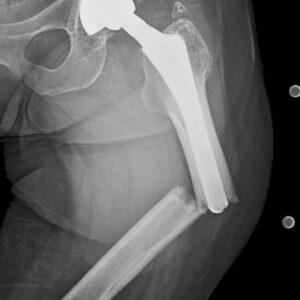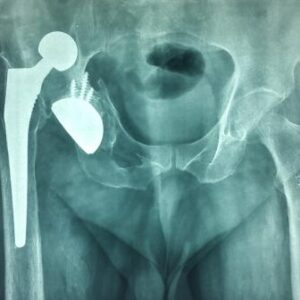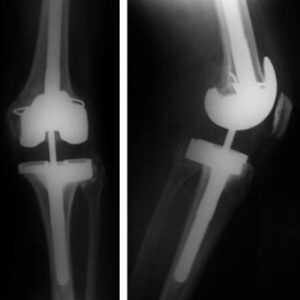Fractures
Preparing for Surgery
Medical Evaluation
You will be asked to schedule a complete physical examination with your primary care doctor several weeks before revision surgery. This is needed to make sure that you are healthy enough to have the surgery and complete the recovery process. Patients with chronic medical conditions, like heart disease, may also be evaluated by a specialist, such as a cardiologist, before surgery.
Tests
Imaging tests. Your doctor will usually order imaging tests to learn more about the condition of your knee.
- X-rays. These provide images of dense structures such as bone. Your doctor may order x-rays taken around the area of the joint replacement to look for loosening or a change in the position of the components.
- Other imaging tests. A nuclear medicine bone scan may help determine if the prosthesis has loosened from the bone. In some cases, a magnetic resonance imaging (MRI) scan or a computerized tomography (CT) scan will be used to help determine why your knee has failed and provide more information about the condition of the bone.
Laboratory tests. To determine whether you have an infection, your doctor may order blood tests. He or she may also aspirate your knee. In this procedure, joint fluid is removed using a needle and syringe, then analyzed in a laboratory to determine if infection is present.
Home Planning
Because your mobility will be limited after surgery, you may need help for several weeks with tasks like cooking, shopping, bathing, and doing laundry if you live alone.
Your doctor’s office, a social worker, or a discharge planner at the hospital can help you make advance arrangements to have someone assist you at home. Depending on your condition, you may need to stay at a nursing facility or rehabilitation center for some time after you leave the hospital. Your healthcare team can also help you arrange for a short stay in an extended care facility during your recovery, if needed.
Complications
As with any surgical procedure, there are risks associated with revision total knee replacement. Because the procedure is longer and more complex than primary total knee replacement, it has a greater risk of complications. Before your surgery, your doctor will discuss each of the risks with you and will take specific measures to help avoid potential complications.
The possible risks and complications of revision surgery include:
- Poor wound healing
- Reduced range of motion or stiffness in the knee
- Infection in the wound or the new prosthesis
- Bleeding
- Blood clots in the legs, which may travel to the lungs (pulmonary embolism)
- Bone fracture during surgery
- Damage to nerves or blood vessels
- Medical problems such as heart attack, lung complications, or stroke
Surgical Procedure
You will either be admitted to the hospital on the day of surgery or you will go home the same day. The plan to be either be admitted or go home should be discussed with your doctor before your surgery.
Anesthesia
Before surgery, you will be evaluated by a member of the anesthesia team. The most common types of anesthesia are general anesthesia (you are put to sleep) or spinal, epidural, or regional nerve block anesthesia (you are awake but your body is numb from the waist down). The anesthesia team, with your input, will determine which type of anesthesia will be best for you.
Procedure
Revision total knee replacement is more complex and takes longer to perform than primary total knee replacement. In complex cases, the surgery may take several hours.
To begin, your doctor will follow the line of the incision made during your primary total knee replacement. The incision may be longer than the original, however, to allow the old components to be removed. Once the incision is made, the doctor will move the kneecap and tendons to the side to reveal your knee joint.
Your doctor will examine the soft tissues in your knee to make sure that they are free from infection. He or she will assess all the metal and/or plastic parts of the prosthesis to determine which parts have become worn or loose or shifted out of position.
If necessary, your doctor will remove the orginal implant very carefully to preserve as much bone as possible. If cement was used in the primary total knee replacement, this is removed, as well. Removing this cement from the bone is a time-consuming process that adds to the complexity and length of the revision surgery.
After removing the original implant, your doctor will prepare the bone surfaces for the revision implant. In some cases, there may be significant bone loss around the knee. If this occurs, metal augments and platform blocks can be added to the main components to make up for the bony deficits.
Rarely, bone graft material may be used to help rebuild the knee. The graft may come from your own bone (autograft) or from a donor (allograft).
Finally, your doctor will insert the specialized revision implant, repair any surrounding soft tissues that are damaged, and carefully test the motion of the joint. A drain may be placed in your knee to collect any fluid or blood that may remain after surgery.
After surgery, you will be moved to the recovery room, where you will remain for several hours while your recovery from anesthesia is monitored. After you wake up, you will be taken to your hospital room.
Your Recovery in the Hospital
If you are admitted to the hospital, you may stay for several days. Although recovery after revision surgery is usually slower than recovery after primary total knee replacement, the type of care you will receive is very similar.
Pain Management
After surgery, you will feel some pain. This is a natural part of the healing process. Your doctor and nurses will work to reduce your pain, which can help you recover from surgery faster.
Medications are often prescribed for short-term pain relief after surgery. Many types of medicines are available to help manage pain, including opioids, nonsteroidal anti-inflammatory drugs (NSAIDs), and local anesthetics. Your doctor may use a combination of these medications to improve pain relief, as well as minimize the need for opioids.
Be aware that although opioids help relieve pain after surgery, they are a narcotic and can be addictive. Opioid dependency and overdose have become critical public health issues in the U.S. It is important to use opioids only as directed by your doctor. As soon as your pain begins to improve, stop taking opioids. Talk to your doctor if your pain has not begun to improve within a few days of your surgery.
Physical Therapy
A physical therapist will give you specific exercises to strengthen your leg and restore range of motion so that you may begin walking and resume other daily activities as soon as possible after surgery.
Blood Clot Prevention
Your doctor may prescribe one or more measures to prevent blood clots and decrease leg swelling. These may include special graded compression stockings, inflatable leg coverings (compression boots), and blood thinners.
Foot and ankle movement also is encouraged immediately following surgery to increase blood flow in your leg muscles to help prevent leg swelling and blood clots.
Preventing Infection
One of the most serious complications facing patients who undergo revision surgery is infection. Although infection occurs in only a small percentage of patients, it can prolong or limit full recovery. To prevent infection, you will be given antibiotics before and, in some cases, after surgery. The risk of infection is slightly higher after revision surgery than after primary total knee replacement.
Your Recovery at Home
You may need some help at home for several days to several weeks after discharge. Before your surgery, arrange for a friend, family member or caregiver to provide help at home. You may need a walker, cane, or crutches for the first few days or weeks until you are comfortable enough to walk without assistance.
Wound Care
You will have stitches or staples running along your wound or a suture beneath your skin on the front of your knee. The stitches or staples will be removed several weeks after surgery. A suture beneath your skin will not require removal.
Avoid soaking the wound in water until it has thoroughly sealed and dried.
Physical Therapy
It is important to continue moving and exercising your knee when you are home. Your physical therapist will provide you with specific exercises to increase your strength and mobility and improve your ability to do everyday activities. You will also work with your therapist to ensure that you can straighten your leg and then bend your knee to at least 90 degrees of flexion.
Preventing Complications
Follow your doctor’s instructions carefully to reduce your risk of developing complications, including blood clots and infection, during the first several weeks of your recovery. He or she may recommend that you continue taking the blood-thinning and antibiotic medications that you started in the hospital.
Long-Term Outcomes
The majority of patients who have revision surgery experience favorable long-term outcomes, including relief from pain and increased stability and function. Complete pain relief and restoration of function is not always achievable, however, and some patients may still experience pain or knee stiffness following revision surgery.







There are no reviews yet.